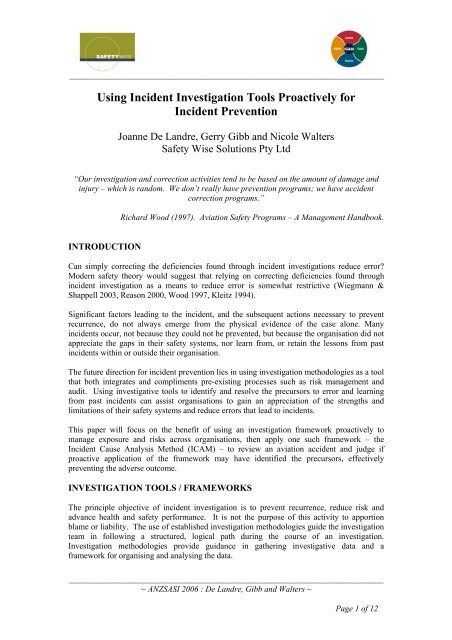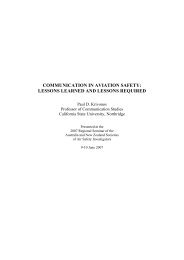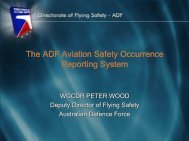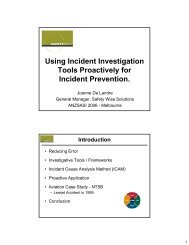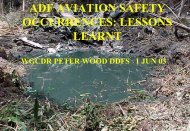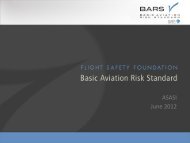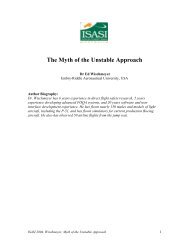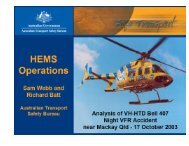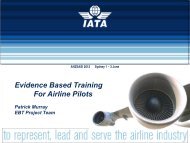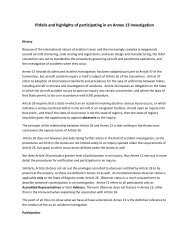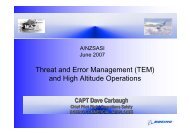Using Incident Investigation Tools Proactively for Incident ... - ASASI
Using Incident Investigation Tools Proactively for Incident ... - ASASI
Using Incident Investigation Tools Proactively for Incident ... - ASASI
Create successful ePaper yourself
Turn your PDF publications into a flip-book with our unique Google optimized e-Paper software.
_____________________________________________________________________<br />
<strong>Using</strong> <strong>Incident</strong> <strong>Investigation</strong> <strong>Tools</strong> <strong>Proactively</strong> <strong>for</strong><br />
<strong>Incident</strong> Prevention<br />
Joanne De Landre, Gerry Gibb and Nicole Walters<br />
Safety Wise Solutions Pty Ltd<br />
“Our investigation and correction activities tend to be based on the amount of damage and<br />
injury – which is random. We don’t really have prevention programs; we have accident<br />
correction programs.”<br />
Richard Wood (1997). Aviation Safety Programs – A Management Handbook.<br />
INTRODUCTION<br />
Can simply correcting the deficiencies found through incident investigations reduce error<br />
Modern safety theory would suggest that relying on correcting deficiencies found through<br />
incident investigation as a means to reduce error is somewhat restrictive (Wiegmann &<br />
Shappell 2003, Reason 2000, Wood 1997, Kleitz 1994).<br />
Significant factors leading to the incident, and the subsequent actions necessary to prevent<br />
recurrence, do not always emerge from the physical evidence of the case alone. Many<br />
incidents occur, not because they could not be prevented, but because the organisation did not<br />
appreciate the gaps in their safety systems, nor learn from, or retain the lessons from past<br />
incidents within or outside their organisation.<br />
The future direction <strong>for</strong> incident prevention lies in using investigation methodologies as a tool<br />
that both integrates and compliments pre-existing processes such as risk management and<br />
audit. <strong>Using</strong> investigative tools to identify and resolve the precursors to error and learning<br />
from past incidents can assist organisations to gain an appreciation of the strengths and<br />
limitations of their safety systems and reduce errors that lead to incidents.<br />
This paper will focus on the benefit of using an investigation framework proactively to<br />
manage exposure and risks across organisations, then apply one such framework – the<br />
<strong>Incident</strong> Cause Analysis Method (ICAM) – to review an aviation accident and judge if<br />
proactive application of the framework may have identified the precursors, effectively<br />
preventing the adverse outcome.<br />
INVESTIGATION TOOLS / FRAMEWORKS<br />
The principle objective of incident investigation is to prevent recurrence, reduce risk and<br />
advance health and safety per<strong>for</strong>mance. It is not the purpose of this activity to apportion<br />
blame or liability. The use of established investigation methodologies guide the investigation<br />
team in following a structured, logical path during the course of an investigation.<br />
<strong>Investigation</strong> methodologies provide guidance in gathering investigative data and a<br />
framework <strong>for</strong> organising and analysing the data.<br />
_____________________________________________________________________<br />
~ ANZSASI 2006 : De Landre, Gibb and Walters ~<br />
Page 1 of 12
_____________________________________________________________________<br />
Modern investigation methodologies not only identify how an incident occurred, but also<br />
identify why it occurred. Most importantly, corrective actions and key learnings arise from<br />
the investigation aimed at preventing similar incidents from occurring again. However, the<br />
effectiveness of corrective actions and key learnings in reducing error is clearly an area which<br />
needs to be improved upon, evidenced by repeat incidents seen through-out many industries.<br />
IMPROVING SAFETY AT AN ORGANISATIONAL LEVEL<br />
Standard investigation methodologies examine the physical evidence at an incident site, the<br />
defences that failed to prevent or mitigate the incident, the actions of people involved, the<br />
conditions that existed and the pertinent organisational factors. While this is usually effective<br />
at determining why a particular accident occurred, the investigation methodology is not<br />
focused on, and there<strong>for</strong>e is not very effective at, making organisations safer.<br />
In order to improve safety at an organisational level and identify and reduce the precursors to<br />
error, a more holistic tool is required which examines the full range of organisational<br />
elements from a proactive stance. While a number of tools can be used <strong>for</strong> this purpose, this<br />
paper will focus on the <strong>Incident</strong> Cause Analysis Method.<br />
INCIDENT CAUSE ANALYSIS METHOD (ICAM)<br />
The principles of the <strong>Incident</strong> Cause Analysis Method (ICAM), stem from the work of<br />
organisational psychologist and human error expert, Professor James Reason and his<br />
modelling of organisational accidents. Reason and his colleagues from the University of<br />
Manchester in the United Kingdom, developed a conceptual and theoretical approach to the<br />
safety of large, complex, socio-technical systems, of which aviation and mining are excellent<br />
examples.<br />
Reason defines organisational accidents as those in which latent conditions (arising mainly<br />
from management decisions, practices or cultural influences), combine adversely with local<br />
triggering conditions (weather, location etc.) and with active failures (errors and/or procedural<br />
violations) committed by individuals or teams at the front line or "sharp end" of an<br />
organisation, to produce an accident (Reason, 1990; 1997).<br />
A fundamental concept of ICAM is acceptance of the inevitability of human error. Human<br />
factors research and operational experience, has shown that human error is a normal<br />
characteristic of human behaviour, and although it can be reduced, it cannot be completely<br />
eliminated (Helmreich & Merritt, 2000). ICAM is designed to ensure that the investigation is<br />
not restricted to the errors and violations of operational personnel. It identifies the local<br />
factors that contributed to the incident and the latent hazards within the system and the<br />
organisation (Gibb & De Landre, 2002). Through the analysis of this in<strong>for</strong>mation, ICAM<br />
provides the ability to identify what really went wrong and to make recommendations on what<br />
needs to be done to prevent recurrence. It is directed towards building error-tolerant defences<br />
against future incidents.<br />
SPECIFIC OBJECTIVES OF ICAM<br />
The specific objectives of investigations using ICAM are:<br />
1. To establish all the relevant and material facts surrounding the event.<br />
2. To ensure the investigation is not restricted to the errors and violations of operational<br />
personnel.<br />
___________________________________________________________________________________<br />
~ ANZSASI 2006 : De Landre, Gibb and Walters ~<br />
Page 2 of 12
_____________________________________________________________________<br />
3. To identify underlying or latent causes of the event.<br />
4. To review the adequacy of existing controls and procedures.<br />
5. To recommend corrective actions which when applied can:<br />
- reduce risk,<br />
- prevent recurrence;<br />
- and by default, improve operational efficiency.<br />
6. Detect developing trends that can be analysed to identify specific or recurring<br />
problems.<br />
7. To ensure that it is not the purpose of the investigation to apportion blame or liability.<br />
Where a criminal act or an act of willful negligence is discovered, the in<strong>for</strong>mation<br />
will be passed to the appropriate authority.<br />
8. To meet relevant statutory requirements <strong>for</strong> incident investigation and reporting.<br />
APPLYING ICAM<br />
ICAM is an analysis tool that sorts the findings of an investigation into a structured<br />
framework. An adaptation of the Reason Model with the ICAM terminology is shown at<br />
Figure 1 below:<br />
Figure 1.<br />
ICAM Model of Accident Causation<br />
The ICAM model organises occurrence causal factors into four elements which are briefly<br />
explained on the following page:<br />
___________________________________________________________________________________<br />
~ ANZSASI 2006 : De Landre, Gibb and Walters ~<br />
Page 3 of 12
_____________________________________________________________________<br />
• Absent / Failed Defences<br />
These contributing factors result from inadequate or absent defences that failed to detect<br />
and protect the system against technical and human failures. These are the control<br />
measures which did not prevent the incident or limit its consequences.<br />
• Individual / Team Actions<br />
These are the errors or violations that led directly to the incident and are typically<br />
associated with personnel having direct contact with the equipment, such as operators or<br />
maintenance personnel.<br />
• Task / Environmental Conditions<br />
These are the conditions in existence immediately prior to, or at the time of the incident<br />
that directly influence human and equipment per<strong>for</strong>mance in the workplace. These are<br />
the circumstances under which the errors and violations took place and can be embedded<br />
in task demands, the work environment, individual capabilities and human factors.<br />
• Organisational Factors<br />
These are the underlying organisational factors that produce the conditions that affect<br />
per<strong>for</strong>mance in the workplace. They may lie dormant or undetected <strong>for</strong> a long time within<br />
an organisation and only become apparent when they combine with other contributing<br />
factors that led to the incident. ICAM classifies the organisational factors into 14<br />
Organisational Factor Types (OFT’s) as seen in Table 1 below:<br />
Table 1<br />
ICAM Organisational Factor Types<br />
HW<br />
TR<br />
OR<br />
CO<br />
IG<br />
PR<br />
MM<br />
DE<br />
RM<br />
MC<br />
CM<br />
OC<br />
RI<br />
OL<br />
Hardware<br />
Training<br />
Organisation<br />
Communication<br />
Incompatible Goals<br />
Procedures<br />
Maintenance Management<br />
Design<br />
Risk Management<br />
Management of Change<br />
Contractor Management<br />
Organisational Culture<br />
Regulatory Influence<br />
Organisational Learning<br />
___________________________________________________________________________________<br />
~ ANZSASI 2006 : De Landre, Gibb and Walters ~<br />
Page 4 of 12
_____________________________________________________________________<br />
APPLYING ICAM PROACTIVELY<br />
While ICAM has proved to be an extremely effective reactive tool with the results of ICAM<br />
investigations being used <strong>for</strong> the development of safety per<strong>for</strong>mance improvement strategies,<br />
the future direction <strong>for</strong> incident prevention lies in the proactive use of the model. Proactive<br />
use of the model provides safety learnings to the organisation without the costs associated<br />
with an occurrence. Additional benefit is gained by applying the model to a number of<br />
similar type, low consequence events, to assess what would otherwise be a set of unrelated<br />
safety concerns and to develop strategic recommendations <strong>for</strong> safety improvements (Gibb &<br />
De Landre, 2003).<br />
For incident reduction to ultimately occur, the precursors to error must be identified and<br />
rectified. While reactive investigation tools are required, they do not necessarily describe how<br />
the precursors to incidents are to be identified in the first place. To address this quandary,<br />
error management systems are needed that will reduce error, mitigate their consequences and<br />
there<strong>for</strong>e, proactively prevent incidents.<br />
The facets of the ICAM error management strategy encompass error prevention, error<br />
containment and error mitigation. Figure 2 below page illustrates how the elements of ICAM<br />
Model can be used <strong>for</strong> a 3-way strategy to manage workplace errors, with the defences within<br />
an organisation directed towards error containment and error mitigation and the organisational<br />
factors aimed at error prevention.<br />
Figure 2.<br />
ICAM 3-way strategy to manage workplace errors<br />
In using the ICAM methodology proactively, the terminology alters and the sequence of<br />
examining the elements changes. As a reactive tool, the Investigator arrives at the incident<br />
site and works back through the elements (shown in Figure 1 on Page 3) starting from the<br />
right-hand side. Firstly the Absent / Failed Defences are identified then the Individual / Team<br />
Actions, then the Task / Environmental Conditions and finally the Organisational Factors.<br />
However, as Figure 1 displays with the appearance of arrows, the actual incident originates<br />
back in the Organisational Factors. When using the ICAM methodology proactively as a risk<br />
management model to enhance safety, the terminology changes as indicated on the following<br />
page in Table 2:<br />
___________________________________________________________________________________<br />
~ ANZSASI 2006 : De Landre, Gibb and Walters ~<br />
Page 5 of 12
_____________________________________________________________________<br />
Table 2.<br />
Titles of Elements <strong>for</strong> Reactive and Proactive Use of ICAM<br />
REACTIVE ICAM ELEMENT<br />
PROACTIVE ICAM ELEMENT<br />
• Absent / Failed Defences • Risk Controls<br />
• Individual / Team Actions • Risk Taking Behaviour<br />
• Task / Environmental Conditions • Risk and Behavioural Influences<br />
• Organisational Factors • Management Controls<br />
Figure 3 below, displays the proactive and reactive direction of use of the model. Proactive<br />
application starts on the left-hand side of the model with Management Controls and works<br />
through the Risk and Behavioural Influences, Risk Taking Behaviour, concluding with the<br />
Risk Controls.<br />
Figure 3.<br />
Reactive vs Proactive Direction of Use of the ICAM Model<br />
As an example of this approach - given a new operation, acquisition of new equipment, staff<br />
selection etc. the use of the Risk Management Model would start by identifying the types of<br />
Management Controls that should be in place aimed at risk reduction and error prevention.<br />
Examples could include: change management strategies, <strong>for</strong>mal risk assessments and training<br />
needs assessments.<br />
___________________________________________________________________________________<br />
~ ANZSASI 2006 : De Landre, Gibb and Walters ~<br />
Page 6 of 12
_____________________________________________________________________<br />
The next step would be to identify the influences on personnel to maintain a safe workplace.<br />
This could include the fact that a Job Safety Analysis is required to be done <strong>for</strong> a particular<br />
task. Following this tools that are available or should be provided to personnel, aimed at<br />
minimising the possibility of errors are identified. These could include training in risk based<br />
decision making or Take 2 type tools. Finally the risk controls that are, or should be, in place<br />
to either trap or mitigate errors are identified.<br />
Where the Risk Management Model identifies specific issues that do not currently exist, such<br />
as lack of appropriate change management processes or scheduled audits etc. then these gaps<br />
obviously need to be rectified to maintain an appropriate level of safety <strong>for</strong> the new operation<br />
/ process.<br />
CASE STUDY – 1999 LEARJET ACCIDENT, ABERDEEN,USA.<br />
From a purely theoretical stance, a Case Study will be examined to demonstrate how the<br />
proactive use of ICAM may have identified precursors to error and identified deficiencies in<br />
the safety system, effectively breaking the links that led to the accident. (It should be noted<br />
that this case study analysis is a subjective view that has been applied after the event and is<br />
based on existing documentation and reports only).<br />
The Case Study selected involved a Learjet Model 35 (N47BA) that crashed on 25 th October<br />
1999 near Aberdeen, South Dakota in the USA. Summary details of the accident appear<br />
below:<br />
SUMMARY REPORT ON THE LEARJET INCIDENT<br />
Excerpt from the National Transportation Safety Board (NTSB) Aircraft Accident Brief<br />
On October 25, 1999, about 1213 central daylight time (CDT), a Learjet Model 35, N47BA,<br />
operated by Sunjet Aviation, Inc., of San<strong>for</strong>d, Florida, crashed near Aberdeen, South Dakota.<br />
The airplane departed Orlando, Florida, <strong>for</strong> Dallas, Texas, at about 0920 eastern daylight<br />
time (EDT). Radio contact with the flight was lost north of Gainesville, Florida, after air<br />
traffic control (ATC) cleared the airplane to flight level (FL) 390.<br />
The airplane was intercepted by several U.S. Air Force (USAF) and Air National Guard<br />
(ANG) aircraft as it proceeded northwestbound at approximately 45,000 feet. The military<br />
pilots in a position to observe the accident airplane at close range stated (in interviews or via<br />
radio transmissions) that the <strong>for</strong>ward windshields of the Learjet seemed to be frosted or<br />
covered with condensation. The military pilots could not see into the cabin. They did not<br />
observe any structural anomaly or other unusual condition.<br />
At approximately 1326 (eastern daylight time) the military pilots observed the airplane depart<br />
controlled flight and spiral to the ground, impacting an open field. All occupants on board the<br />
airplane (the captain, first officer, and four passengers - including professional golfer, Payne<br />
Stewart) were killed, and the airplane was destroyed (NTSB, 2001; 2005).<br />
Applying ICAM to this accident, it is possible, <strong>for</strong> illustrative purposes to identify latent<br />
conditions and factors that could have been identified prior to the accident. Due to the nature<br />
of the accident, with the speed of impact described as near supersonic, much of the physical<br />
evidence was destroyed preventing a more definitive analysis of technical and human causal<br />
factors.<br />
___________________________________________________________________________________<br />
~ ANZSASI 2006 : De Landre, Gibb and Walters ~<br />
Page 7 of 12
_____________________________________________________________________<br />
The NTSB (2005) noted the challenges and difficulties with the investigation by stating:<br />
“This investigation took 13 months to complete and was hampered by several factors:<br />
- Because the aircraft impacted at nearly supersonic speed and at an extremely steep<br />
angle, none of its components remained intact. There<strong>for</strong>e, investigators had to<br />
painstakingly examine the fragmented valves, connectors, and portions of other<br />
aircraft parts be<strong>for</strong>e they could draw any conclusions about the accident's cause.<br />
- The airplane was not equipped with a flight data recorder, an invaluable tool in most<br />
major investigations, and it had only a 30-minute cockpit voice recorder, which was<br />
of limited use during this investigation.<br />
- And, all of the investigators involved in this investigation were also investigating<br />
other accidents. The Investigator-in-Charge was working on four other investigations<br />
in addition to this one.”<br />
APPLICATION OF ICAM TO THE CASE STUDY<br />
Absent / Failed Defences<br />
Absent or failed defences are those contributing factors that failed to detect and protect the<br />
system against technical and human factors. These are the control measures that did not<br />
prevent the incident or limit its consequences. Some of the Absent / Failed Defences<br />
identified in the accident included:<br />
- Cabin pressurisation (inability to maintain)<br />
- Bleed air supply to the cabin (lack of)<br />
- Flow control valve - supplying warm air to windshield (closed)<br />
- Timeliness/warning <strong>for</strong> donning oxygen masks (adequacy )<br />
- Oxygen quality/quantity<br />
- Incomplete standardised manual and procedures<br />
- Ambiguous maintenance procedures, some verbal, some written, some not signed<br />
off.<br />
- Poor written reporting relationship between aircrew and maintenance staff<br />
- Non adherence to company policy <strong>for</strong> maintenance reporting/signoff<br />
- Inadequate procedures <strong>for</strong> emergency oxygen supply<br />
- Unclear whether guidance provided <strong>for</strong> procedures anomaly – switching to auto<br />
pilot<br />
- Procedures <strong>for</strong> reporting maintenance issues inadequate<br />
- Written records <strong>for</strong> maintenance reports incomplete<br />
- Application of SOP’s (previous inconsistencies)<br />
- Crew pairing (Inexperienced Captain with First Officer)<br />
- Flying time on type (Captain limited)<br />
Individual / Team Actions<br />
Individual / Team Actions are the errors or violations that led directly to the incident. They<br />
are typically associated with personnel having direct contact with the equipment, such as<br />
operators or maintenance personnel. They are always committed actively (someone did or did<br />
not do something) and have a direct relation with the incident. Some of the Individual / Team<br />
Actions identified in the accident included:<br />
___________________________________________________________________________________<br />
~ ANZSASI 2006 : De Landre, Gibb and Walters ~<br />
Page 8 of 12
_____________________________________________________________________<br />
- Timeliness in donning oxygen masks<br />
- Descending to a lower, safe altitude<br />
- Lack of verbal response from crew to ATC radio contact<br />
Task / Environmental Conditions<br />
These are the conditions in existence immediately prior to or at the time of the incident that<br />
directly influence human and equipment per<strong>for</strong>mance in the workplace. These are the<br />
circumstances under which the errors and violations took place and can be embedded in task<br />
demands, the work environment, individual capabilities and human factors. Some of the Task<br />
/ Environmental Conditions identified in the accident included:<br />
- Loss of cabin pressurisation<br />
- Flow control valve closed<br />
- Limited time on type<br />
- High altitude<br />
- Low pressure evident in cabin (via alarm)<br />
- Ambiguity surrounding effectiveness of alarm system<br />
- Lack of supplemental oxygen<br />
- Hypoxia / Incapacitation<br />
Organisational Factors<br />
These are the underlying organisational factors that produce the conditions that affect<br />
per<strong>for</strong>mance in the workplace. They may lie dormant or undetected <strong>for</strong> a long time within an<br />
organisation and only become apparent when they combine with other contributing factors<br />
that led to the incident. Some of the Organisational Factors identified in the accident<br />
included:<br />
- Deficient monitoring/ auditing of maintenance item completion<br />
- Equipment not fit <strong>for</strong> purpose- suspected valve problems with closure of flow control<br />
valve.<br />
- Process of (managing) introduction of new aircraft<br />
- <strong>Incident</strong> reporting system deficiencies<br />
- Inadequate procedures <strong>for</strong> checking quality and quantity of on board emergency<br />
oxygen bottle<br />
- Deficiencies in maintenance control – use of MEL etc.<br />
- No evidence of risk appreciation process used<br />
- Ambiguous monitoring by management of resources, climate and processes of a safe<br />
working environment<br />
- Incomplete corporate commitment to safety<br />
- Failure to revise maintenance strategy<br />
- Failure to appreciate the risk exposure or vulnerability within the organisation<br />
- No follow-up from previously failed defenses – identification, tracking and resolving<br />
maintenance items and adverse trends<br />
IDENTIFYING THE PRECURSORS<br />
The lack of physical evidence at the crash site, the lack of complete documentation, data and<br />
records left sufficient doubt about the exact cause of this accident. The NTSB determined<br />
that the probable cause was incapacitation of the flight crew members as a result of their<br />
failure to receive supplemental oxygen following a loss of cabin pressurisation, <strong>for</strong><br />
undetermined reasons (NTSB 2001).<br />
___________________________________________________________________________________<br />
~ ANZSASI 2006 : De Landre, Gibb and Walters ~<br />
Page 9 of 12
_____________________________________________________________________<br />
The application of a proactive tool prior to the accident, may have been able to identify the<br />
precursors to the accident and broken the error chain. Given some of the contributing factors<br />
identified during the investigation and the type of issues that are typically found during the<br />
proactive application of ICAM, factors that were judged as being precursors to error that may<br />
well have been identified include:<br />
- Poor follow through on work procedures regarding maintenance reporting,<br />
identification, tracking and resolving of maintenance items and adverse trends.<br />
- Incomplete standardised manual and procedures.<br />
- Monitoring / auditing processes.<br />
- Change management issues with the purchase of a new aircraft.<br />
- Adequacy of procedures <strong>for</strong> checking quality and quantity of on-board emergency<br />
oxygen bottle.<br />
- Condition of equipment (highlighting ventilation issues previously identified and<br />
repaired).<br />
- Anomaly of practices regarding the timing of switching to auto pilot.<br />
- Crew pairing (given experience/hours on type)<br />
- Risk Management<br />
BENEFIT OF PROACTIVE APPROACHES<br />
There is no doubt that a proactive error management strategy that leads to overall incident<br />
reduction is beneficial <strong>for</strong> all organisations and can be measured in both tangible and<br />
intangible means. The proactive use of tools such as ICAM, can provide safety learnings to<br />
an organisation without the costs associated with an incident. Applying ICAM as a<br />
preventive tool allows an organisation to shift its focus from investigation findings to<br />
preventative safety. By designing error tolerant workplaces that will reduce error,<br />
organisations have the potential to mitigate error consequences and there<strong>for</strong>e, proactively<br />
prevent incidents.<br />
Adopting this approach <strong>for</strong> all levels of work operations, processes etc. can be beneficial. If<br />
preventive ef<strong>for</strong>ts are applied only to events with the ‘highest’ likelihood of disaster, the<br />
opportunity is missed to prevent a regularly recurring event of ‘low’ probability, which may<br />
have latent effects, <strong>for</strong> example in the case study - the maintenance reporting and follow<br />
through procedures.<br />
CONCLUSION<br />
Correcting the deficiencies found using standard reactive incident investigation methods<br />
should reduce and manage the errors that led to a particular incident, but in order to reduce the<br />
precursors to error and fundamentally improve the safety of an organisation, a more holistic,<br />
proactive approach is required.<br />
ICAM is one such method, which demonstrates commitment to continual improvement in<br />
per<strong>for</strong>mance and safety by addressing the latent conditions and hazards in the system that<br />
produce human error. The proactive use of ICAM as a tool that both integrates with and<br />
___________________________________________________________________________________<br />
~ ANZSASI 2006 : De Landre, Gibb and Walters ~<br />
Page 10 of 12
_____________________________________________________________________<br />
compliments proactive processes such as risk management and audit, expands the utility of<br />
ICAM and may enable the precursors to occurrences to be identified and remedied prior to an<br />
actual occurrence saving time, money and perhaps lives.<br />
~~~~~~~~~~~~~~~~~~~~~~~~~~~~~~~~~~~~~~~~~~~~~~~~~~~<br />
___________________________________________________________________________________<br />
~ ANZSASI 2006 : De Landre, Gibb and Walters ~<br />
Page 11 of 12
_____________________________________________________________________<br />
REFERENCES<br />
Gibb, G., & De Landre J. (2003). Designing an Error Tolerant Workplace: <strong>Using</strong> ICAM<br />
<strong>Proactively</strong>. Paper prepared <strong>for</strong> NSW Mining OHS conference, August 2003.<br />
Gibb, G., & De Landre J. (2002). Lessons from the mining industry. Paper prepared <strong>for</strong> the<br />
Human Error, Safety and Systems Development (HESSD) Conference, Newcastle, NSW, 17<br />
June 2002.<br />
Helmreich, R.L., & Merritt, A.C. (2000). Safety and error management: The role of Crew<br />
Resource Management. In B.J. Hayward & A.R. Lowe (Eds.), Aviation Resource<br />
Management (pp. 107-119). Aldershot, UK: Ashgate.<br />
Kleitz, T. (1994). Lessons From Disaster. Published by the Institution of Chemical Engineers,<br />
UK - ISBN 0 85295 307 0.<br />
National Transportation Safety Board. Default in<strong>for</strong>mation page DCA00MA005 Retrieved 15<br />
November 2005. Available: http://www.ntsb.gov/events/aberdeen/default.htm<br />
National Transportation Safety Board. (2001). Aircraft accident brief DCA00MA005.<br />
February 2001. Author.<br />
Reason, J. (2000). Human error: Models and management. British Medical Journal, 320, 768-<br />
770.<br />
Reason, J. (1997). Managing the risks of organizational accidents. Aldershot, UK: Ashgate.<br />
Reason, J. (1990). Human error. New York: Cambridge University.<br />
Wiegmann, D.A. and Shappell, S.A. (2003). A human error approach to aviation accident<br />
analysis. Aldershot, UK. Ashgate.<br />
Wood, R. (1997). Aviation Safety Programs. A management handbook. 2 nd Ed. Colorado,<br />
USA. Jeppesen.<br />
___________________________________________________________________________________<br />
~ ANZSASI 2006 : De Landre, Gibb and Walters ~<br />
Page 12 of 12


